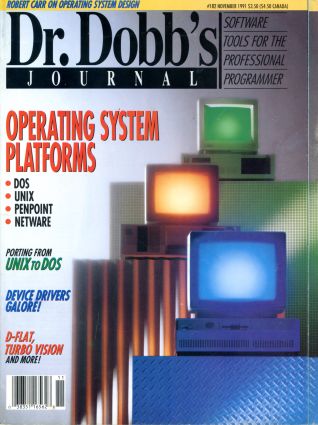
p.6 EDITORIAL
[author : Jonathan Erickson] #Edito
TABLE OF CONTENTS
FEATURES
p.14 A CONVERSATION WITH ROBERT CARR
[author : Michael Swaine]
This month's "Programming Paradigms" moves to the forefront as Michael converses with Robert Carr, chief architect of PenPoint, a 32-bit, multitasking, object-oriented operating system. Ray Valdes adds a technical overview of the DOS.
p.30 LOADING DEVICE DRIVERS FROM THE DOS COMMAND LINE
[author : Jim Kyle]
DEVLOD, the DOS program Jim presents here, lets you load character and block device drivers without rebooting your computer.
p.46 PORTING UNIX TO THE 386: THE BASIC KERNEL
[author : William Frederick Jolitz and Lynne Greer Jolitz]
It's necessary to understand UNIX device interfaces before integrating device drivers. Bill and Lynne examine BSD kernel/device driver interfaces and how BSD works the miracle of autoconfiguration.
p.62 DDJ DATA COMPRESSION CONTEST RESULTS
[author : Mark Nelson]
Mark reveals the results of our data compression contest. And the winners are...
EXAMINING ROOM
p.68 PORTING UNIX APPLICATIONS TO DOS
[author : David N. Glass]
What kind of problems can you expect when porting large programs from UNIX to DOS? For starters, the OSs treat devices and files differently. David dealt with this—and more—when his shop ported nearly 250,000 lines of C from UNIX to DOS.
PROGRAMMER'S WORKBENCH
p.82 MONITORING DISTRIBUTED PRINTERS UNDER NOVELL NETWARE
[author : V. James Krammes]
This month's project is a program that allows you to monitor multiple remote printers from a single workstation using the Novell NetWare C Interface for DOS.
COLUMNS
p.105 C PROGRAMMING
[author : Al Stevens]
Al begins a discussion of specific window classes by reviewing the classes that D-Flat provides, discussing how the class hierarchy works, and describing the NORMAL class, which is the base class from which all others derive.
p.115 STRUCTURED PROGRAMMING
[author : Jeff Duntemann]
Jeff takes on the challenge of Turbo Vision, the object-oriented toolbox that's part of the Turbo Pascal 6.0 package, starting with his four basic rules for Turbo Vision programming.
p.123 GRAPHICS PROGRAMMING
[author : Michael Abrash]
Looking good is good enough when it comes to antialiasing with 32 fully independent levels of each primary color, and resolutions up to 800x600.
p.131 PROGRAMMER'S BOOKSHELF
[author : Ray Duncan]
The Art of Human-Computer Interface Design and Disappearing Through the Skylight are examined this month, along with a look at how cyberpunk science fiction novels view human-computer interfaces.
DEPARTMENTS
p.8 LETTERS
[author : you]
p.160 SWAINE'S FLAMES
[author : Michael Swaine]
PROGRAMMER'S SERVICES
p.150 OF INTEREST
[author : Tami Zemel]
